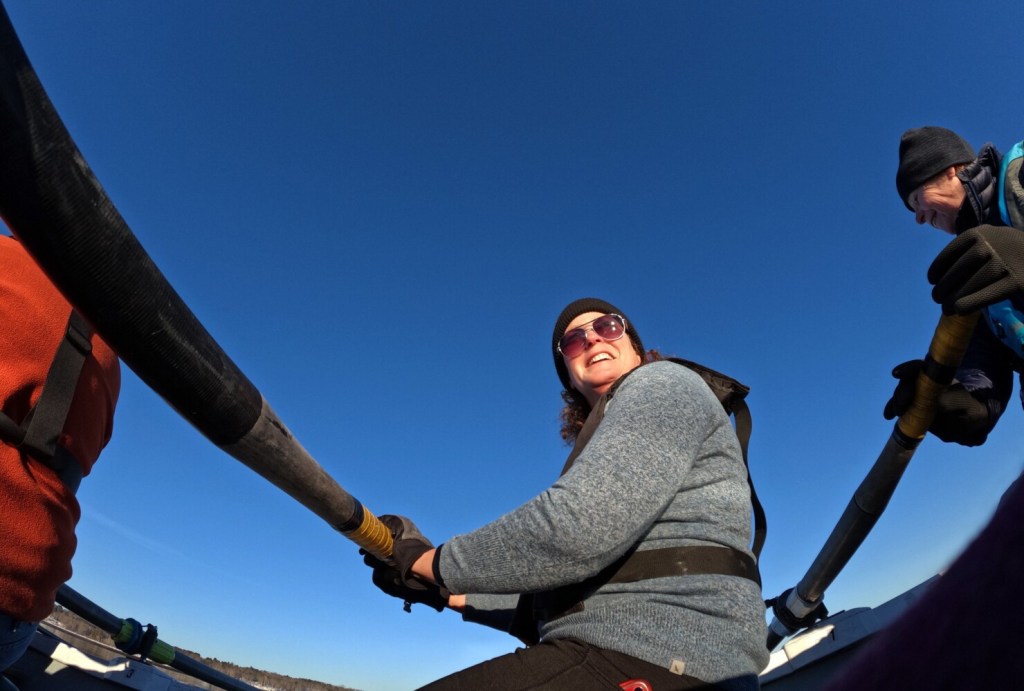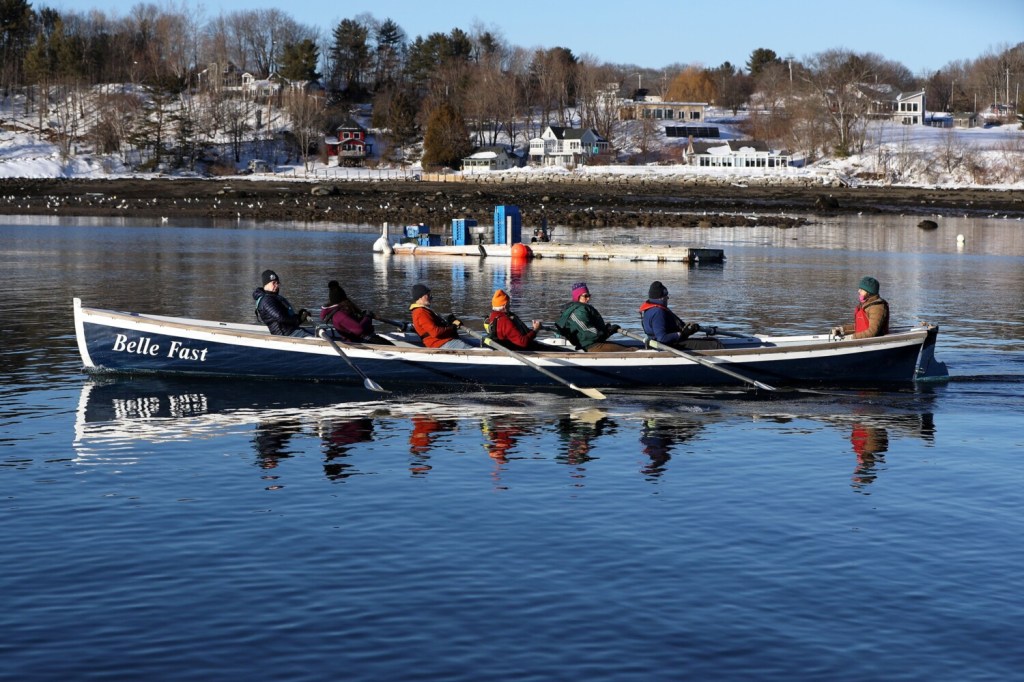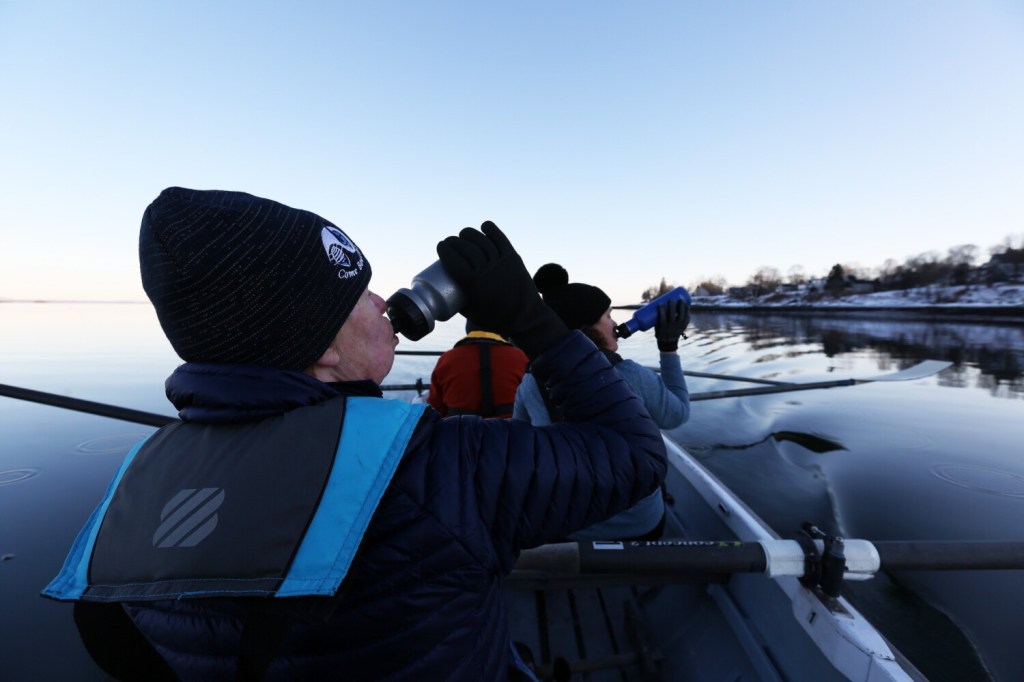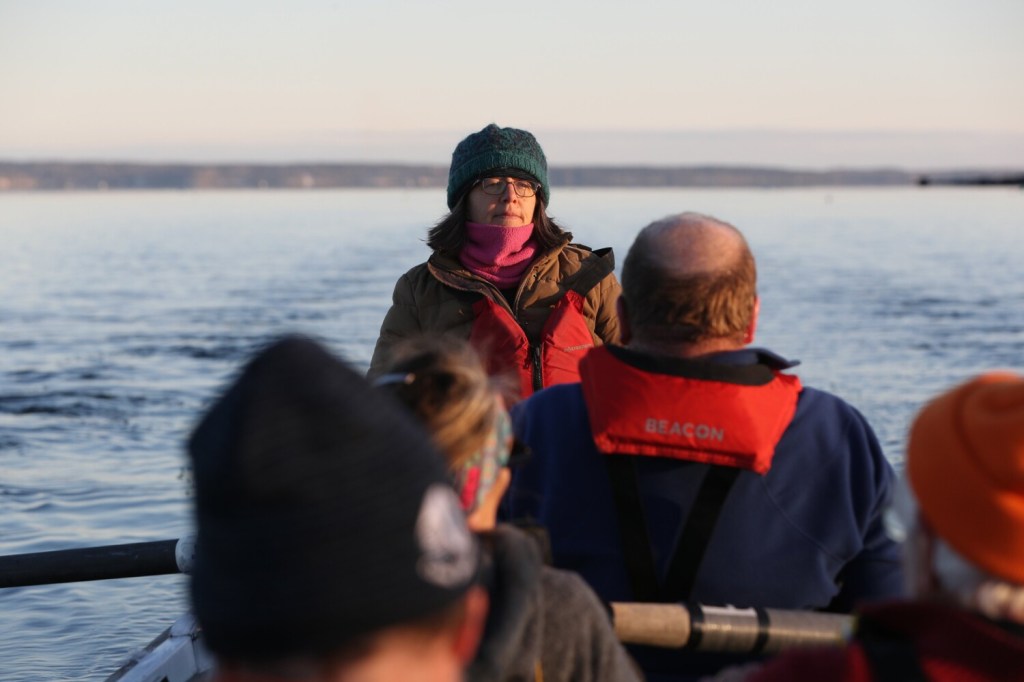BELFAST — The docks were free of ice, a promising sign. Still, three rowers carefully made their way down a plank onto the dock to shovel off snow and ready it for Belfast’s community rowing program, Come Boating.
When four more rowers showed up, the group together unhooked the tarp covering a 32-foot-long wooden boat, taking care not to slip into the frigid waters of Belfast Harbor. Then, one by one, six rowers and a coxswain called out the nautical term, “laying on,” and stepped into the boat.
From the back seat, Mickey Green, bundled in a down jacket and winter hat, couldn’t wait.
“These Cornish pilot gigs take a lot to capsize. They’re big and heavy. I feel safe,” said Green, who moved to Belfast in 2015 with her husband, Sam. “And it’s informal. And you’re with a wonderful bunch of people. It’s always one of the best parts of my week.”
Cornish pilot gigs are six-oared wooden boats with a rich history. And by all accounts, everyone in Belfast who wants to try rowing these wooden rowboats – a tradition that dates back centuries – is smitten with it.
Come Boating works to help more people connect with the ocean. The annual membership of $25 gets you many days a week rowing on Penobscot Bay in the spring, summer and fall, and – if a rower proves proficient – one or more along the Belfast coast in winter.
“Back in Cornwall (England) in the 1700s, the merchant ships that came to Cornwall needed a pilot to help them navigate the coast to get into the harbor. Whoever got to the ship first got to pilot it in. So they would race in the open water to the merchant ships. That’s where the tradition comes from,” said coxswain Susan Cutting. “These boats are designed and built to race in the open ocean, which is totally cool.”
The same style of rowboats built for the job of piloting in schooners in the late 1700s are used today by 86 pilot gig clubs in the United Kingdom. There also are other rowing clubs in the United States that race Cornish pilot gigs up and down the Northeast, including the Belfast club.
The Belfast club has three Cornish pilot gigs. Over the course of last summer, the club took out 100 to 200 rowers on rows that typically lasted an hour or more. The winter is a different story – with only 48 approved winter rowers this winter – and only around 20 who frequently show.
Anyone is welcome to try rowing with Come Boating in the summer, but rowing the gigs in the winter is a far grittier, more demanding experience. All winter rowers have to be recommended by three different coxswains, proving strength and skill at handling the oars. Crews don’t go out in winter unless the wind is under 14 knots and the temperature is above 20 degrees.
“However, we do specify that an experienced crew can bypass those guidelines if every member is comfortable. I’ve been out this season in conditions much colder than 20,” said Tanya Lubansky, the program’s winter rowing coordinator.
While the coxswains who lead the group make safety a priority at every step, the crews are largely alone in Belfast Harbor or – when the tides are right – rowing up the Passagassawakeag River, since most boats are out of the water and stored in wintertime.
Cutting got into Come Boating like many. She heard about it several years ago, tried it once, and instantly became a regular. Now she’s an experienced coxswain who gives back in the winter by coxing other rowers, rather than rowing herself at every chance. At the end of the row she coxed two weeks ago, all the rowers thanked her as they said goodbye.
“I had never rowed in anything. I fell in love with it. That’s what can happen. It’s a wonderful source of exercise,” Cutting said.
Sam and Mickey Green moved to Belfast from Washington, D.C., because of the harbor and, in fact, because of Come Boating. They both had rowed at a club in Washington, D.C., on the Potomac or Anacostia rivers.
“When we were sailing around Maine on our sailboat, we rented a mooring and Sam talked to the harbormaster, and she told him about Come Boating. This area had all the ingredients. But one of the draws was the rowing club,” Green said.
Now they live right on the Passagassawakeag River and Mickey Green, who retired last year, rows a few times a week – even in winter. Her favorite day to row is Sunday in the summer, when the group can row farther out into Penobscot Bay and stop. The ritual they embrace is to float for 10 to 15 minutes in silence.
“It’s a moment of mediation and reflection. You’re out there in nature. You don’t have that space very often, to be in that quiet, that mood,” Green said. “I don’t go to church. That is my church.”
Russ Eagleston and his wife, Noreen, moved to Northport last March. Like Cutting, he had never rowed before. And the retired commercial airline pilot has embraced rowing with an absolute fervor.
In less than a year, Eagleston worked his way up to the winter crew. Recently, he was selected to be in the recreational boat that will race in a winter race in March in Hull, Massachusetts. And this spring, Eagleston plans to take a boatbuilding class in Annapolis, Maryland, so he will have his own one-person wooden boat and can row all the time.
“When I first learned, I was sore for six weeks. It’s the hardest abdominal workout ever,” said Eagleston, 66. “I had trouble feathering (turning the oar) without getting it hung up. But it was a nice group of people. They’re very welcoming. I was rowing almost five times a week in the summer. Winter rowing is more challenging. It’s not about being faster, not about strength, it’s more about timing, technique. It’s great exercise.”
Send questions/comments to the editors.















